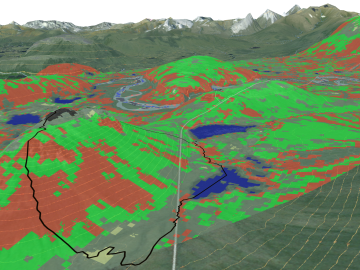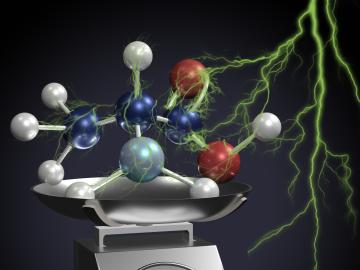
Filter News
Area of Research
- (-) Materials (104)
- (-) Neutron Science (38)
- (-) Supercomputing (96)
- Advanced Manufacturing (22)
- Biology and Environment (113)
- Biology and Soft Matter (1)
- Building Technologies (1)
- Computational Biology (1)
- Computational Engineering (2)
- Computer Science (9)
- Electricity and Smart Grid (3)
- Energy Frontier Research Centers (1)
- Energy Science (227)
- Functional Materials for Energy (1)
- Fusion and Fission (31)
- Fusion Energy (17)
- Isotopes (2)
- Materials for Computing (17)
- Mathematics (1)
- National Security (33)
- Nuclear Science and Technology (20)
- Nuclear Systems Modeling, Simulation and Validation (1)
- Quantum information Science (3)
- Sensors and Controls (2)
- Transportation Systems (2)
News Topics
- (-) 3-D Printing/Advanced Manufacturing (30)
- (-) Advanced Reactors (6)
- (-) Artificial Intelligence (41)
- (-) Clean Water (4)
- (-) Environment (40)
- (-) Fusion (9)
- (-) Grid (9)
- (-) Microscopy (29)
- (-) Nanotechnology (46)
- (-) Quantum Computing (21)
- (-) Security (7)
- (-) Transportation (23)
- Big Data (23)
- Bioenergy (22)
- Biology (19)
- Biomedical (33)
- Biotechnology (2)
- Buildings (8)
- Chemical Sciences (34)
- Composites (9)
- Computer Science (101)
- Coronavirus (22)
- Critical Materials (15)
- Cybersecurity (9)
- Energy Storage (41)
- Exascale Computing (26)
- Fossil Energy (1)
- Frontier (33)
- High-Performance Computing (46)
- Hydropower (1)
- Irradiation (1)
- Isotopes (14)
- ITER (1)
- Machine Learning (17)
- Materials (86)
- Materials Science (90)
- Mathematics (2)
- Molten Salt (3)
- National Security (8)
- Neutron Science (129)
- Nuclear Energy (22)
- Partnerships (11)
- Physics (36)
- Polymers (19)
- Quantum Science (36)
- Simulation (16)
- Software (1)
- Space Exploration (7)
- Summit (43)
Media Contacts

Oak Ridge National Laboratory scientists have created open source software that scales up analysis of motor designs to run on the fastest computers available, including those accessible to outside users at the Oak Ridge Leadership Computing Facility.
OAK RIDGE, Tenn., Feb. 12, 2019—A team of researchers from the Department of Energy’s Oak Ridge and Los Alamos National Laboratories has partnered with EPB, a Chattanooga utility and telecommunications company, to demonstrate the effectiveness of metro-scale quantum key distribution (QKD).

OAK RIDGE, Tenn., Feb. 8, 2019—The Department of Energy’s Oak Ridge National Laboratory has named Sean Hearne director of the Center for Nanophase Materials Sciences. The center is a DOE Office of Science User Facility that brings world-leading resources and capabilities to the nanoscience resear...
Scientists at the Department of Energy’s Oak Ridge National Laboratory (ORNL) have developed a process that could remove CO2 from coal-burning power plant emissions in a way that is similar to how soda lime works in scuba diving rebreathers. Their research, published January 31 in...

A team of scientists led by Oak Ridge National Laboratory used machine learning methods to generate a high-resolution map of vegetation growing in the remote reaches of the Alaskan tundra.

OAK RIDGE, Tenn., Jan. 31, 2019—A new electron microscopy technique that detects the subtle changes in the weight of proteins at the nanoscale—while keeping the sample intact—could open a new pathway for deeper, more comprehensive studies of the basic building blocks of life.

Oak Ridge National Laboratory scientists studying fuel cells as a potential alternative to internal combustion engines used sophisticated electron microscopy to investigate the benefits of replacing high-cost platinum with a lower cost, carbon-nitrogen-manganese-based catalyst.

Scientists at the Department of Energy’s Oak Ridge National Laboratory have created a recipe for a renewable 3D printing feedstock that could spur a profitable new use for an intractable biorefinery byproduct: lignin.
![2018-P07635 BL-6 user - Univ of Guelph-6004R_sm[2].jpg 2018-P07635 BL-6 user - Univ of Guelph-6004R_sm[2].jpg](/sites/default/files/styles/list_page_thumbnail/public/2018-P07635%20BL-6%20user%20-%20Univ%20of%20Guelph-6004R_sm%5B2%5D.jpg?itok=hUSyvkP0)
A team of scientists, led by University of Guelph professor John Dutcher, are using neutrons at ORNL’s Spallation Neutron Source to unlock the secrets of natural nanoparticles that could be used to improve medicines.

Carbon fiber composites—lightweight and strong—are great structural materials for automobiles, aircraft and other transportation vehicles. They consist of a polymer matrix, such as epoxy, into which reinforcing carbon fibers have been embedded. Because of differences in the mecha...


